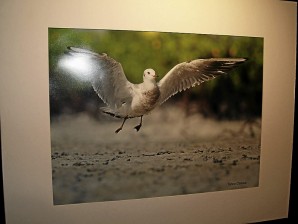Bird flights help track climate change

THE EXHIBIT also features the black-headed gull breeds in Europe, Asia and Northern America. JESSIE M. CUBIJANO/CONTRIBUTOR
CEBU—For nature photographers like Nilo Arribas Jr., it is more than a privilege to take images that document how migratory birds live and behave in the wild.
With their works, Arribas and five other photographers belonging to a small group called the Cebu Birdnuts mounted an exhibit in July, featuring 18 migratory birds in the 920-hectare Olango Island Wildlife Sanctuary (OIWS) in Lapu-Lapu City.
“It takes a lot of patience, passion, determination and time to take these shots. As bird watchers, we enjoy doing this, but it is also our way of communicating the message that looking at the migration behavior of these birds gives us a glimpse of what climate change is,” Arribas says.
He says the normal migratory schedule of the birds has changed, some arriving earlier than expected. The photographers took this as a sign of rapidly changing climate.
Arribas, Bobby Kintanar, Clemn Macasiano Jr., Marester Bas Macasiano, Tateo Osawa and Dr. Luisito Co mounted the bird exhibit. The idea, Arribas says, stemmed from casual coffee sessions.
Article continues after this advertisementAs photographers, he says, they share one complaint in bird photography—hard disks full of bird photos.
Article continues after this advertisement“We thought that there has to be a mechanism where we can share these photos and at the same time, share to the public a different perspective on climate change,” he notes.
They drew the support of SM City Cebu, Pacific Online Systems Corp., Wild Bird Club of the Philippines Inc. and the Rambon Aboitiz Foundation Inc. The exhibit became the first of a series aimed at raising public awareness of migratory birds and their relationship with the environment.
Taking center stage at SM City Cebu’s Northwing were the red-necked stint, whimbrel, little egrets, Asian Dowitcher, Ruddy turnstone, grey-tailed tattler, Pacific Golden Plover, black-headed gull and Bar-tailed Godwit.
Fast facts of each migratory bird gave viewers a peek of its breeding area and migratory path. “We know that photographs may not be enough to explain (what a bird is). We enjoy doing this and this is our commitment as bird watchers and photographers,” Arribas says.
Known as the refueling station for migratory birds, Olango stands at the crossroads of migration. The island is part of the East Asian Migration Flyway, where birds from Siberia, Mongolia, Japan and China seek temporary shelter on their way to New Zealand and Australia.
Migration starts in September, but most birds are found in Olango in November, according to Mario Marababol, Oceancare Advocates administrator and marine biologist. Birds, however, flock to the island until February.
Marababol says the OIWS was included on the Ramsar List of Wetlands of International Importance in July 1994, making it the first wetland of international importance for waterfowl in the Philippines.
“(This) means that Olango is a strategic place where birds could rest and recover from injury after long months of journey. It is strategic as resting place because of abundance of food, shelter and (presence of fewer) … predators,” he says.
Bird poetry
When the photo exhibit was launched on July 6, Regional Trial Court Judge Simeon Dumdum Jr. read poems from his book “If I Write You This Poem, Will You Make It Fly?” The book contains poems of 129 kinds of birds using various verse forms.
Dumdum says birds are true travelers who can visit one country after another without any passport and visa.
“Birds are truly the real global ambassadors. They leave their countries when its cold and then, they return when their home countries warm up again,” he shares.